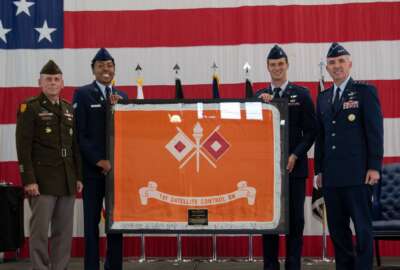Air Force needs to clarify its goals for space technology acquisition
A new report from RAND Corporation reviewed two distinct technologies to illustrate ways the Air Force needs to align its goals with expense and risk in developing...
The Defense Department can improve the acquisition process for space technology with more “market intelligence.” Its acquisition leaders need to make clearer distinctions between investing in programs that will have limited commercial support and in programs that have broader commercial applications.
A new report from RAND Corporation, initiated at the request of the Air Force, looked at the way the department developed and acquired new technologies, and how it could get access to a broader spectrum of innovation.
Jonathan Wong, a senior researcher for the report and an analyst for RAND, said contracting officers need a more sophisticated view of how the commercial marketplace for technology works.
“I think there’s a greater need for understanding how markets and firms behave in a non-defense prime world because defense primes are a different beast in terms of the way they behave financially,” Wong said. “It’s not difficult. It’s just a different framework that I think the acquisition community, the requirements community needs to take a look at.”
He said in some cases, market intelligence is a matter of understanding the limitations of the commercial market.
“I think there’s a great opportunity there, but they have to be a little more clear, honest with themselves and intentional with themselves and with their commercial partners about what they want out of those services,” Wong said.
Two different technology markets
The researchers picked two technologies to study for the report — one older and well-established, and one emerging market. They looked at commercial satellite communications, an industry with a long history and a healthy commercial base. For the newer industry, the team picked commercial space-based positioning, navigation, and timing (PNT).
PNT operates as a more precise alternative to Global Positioning Systems (GPS) and could offer the military an alternative in the case of disrupted GPS. Wong said PNT generated a lot of enthusiasm at the Pentagon.
“One of the things that really struck us when we first started the research was how excited parts of the DoD were to invest in this. There’s greater accuracy, there was interest in finding some sort of redundant capability should GPS be denied or degraded in a given environment,” Wong said.
However, Wong said currently, the only commercial use for PNT is in navigating systems for autonomous vehicles. While it would provide greater accuracy than GPS, the expense and time needed to develop it as a commercial capability would be a hard sell to an industry already effectively using GPS.
“When we looked at the funding picture for some of these firms, what they’re trying to accomplish and how much funding they’ve been able to attract on the commercial side, it would be very likely that the DoD would have to be a tentpole investor in this in order to get these things off the ground,” Wong said.
To commit to a PNT program, the Pentagon would have to consider itself almost the sole backer of the program, with an uncertain future for commercial viability. Wong said backing a program that way isn’t necessarily wrong, but DoD should be clear about what they are getting into and make sure they need the technology enough to justify the commitment.
“We realized that for the DoD, they hadn’t really thought about it. We have a sense that these things are really important. But we couldn’t see an explicit strategy — what are the particular goals that they’re after in commercial space services?” Wong said.
Evaluating the risk
The report recommended the Air Force consider the long-term risk of PNT. Without a commercial market, there was no promise of long-term industrial base stability. It said the service should adopt a wait-and-see approach using more limited investment strategies, such as prototypes and pilot programs when market conditions and the operational utility of the commercial service are uncertain.
At the other end of the spectrum, the communications satellites checked the blocks for commercial viability and long-term industrial base stability. The report concluded that the Pentagon could take more risks in the acquisition of the satellite communication program because of its established track record.
“We know there’s a healthy commercial demand for commercial satellite communications and that gives a cushion that we looked at in the market and we saw that DoD is not the biggest customer in using commercial satellite communications. It’s quite diversified,” Wong said. “We looked at the financials for the firms that are involved — there’s a lot more than in the commercial PNT market.”
Even with the greater risk involved with developing PNT, Wong said the report didn’t conclude it was a bad idea, just one that the Air Force should understand and be realistic about the risks and limitations.
“I don’t want to pour cold water on the work that maybe these commercial firms are doing. I think it’s quite exciting. But I think the challenge and the point that we’re trying to make for the DoD is that there was no strategy when we wrote this piece and I don’t see that DoD really articulated what it wants, other than just a general sense of ‘I want some more of that Silicon Valley,”” Wong said.
Copyright © 2025 Federal News Network. All rights reserved. This website is not intended for users located within the European Economic Area.
Alexandra Lohr, a former staff member, covered the Defense Department for Federal News Network until September 2023.






